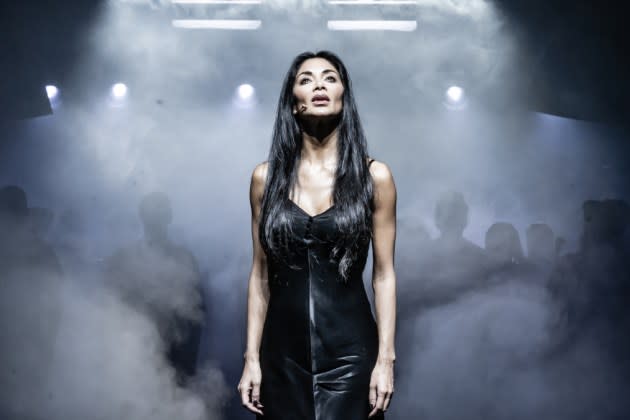‘Sunset Boulevard’ Review: Nicole Scherzinger Delivers in a Technologically Audacious but Emotionally Empty Reimagining
- Oops!Something went wrong.Please try again later.
- Oops!Something went wrong.Please try again later.
- Oops!Something went wrong.Please try again later.

There’s a strong case for saying that the song “As If We Never Said Goodbye,” sung during Norma Desmond’s return to Paramount Studios in “Sunset Boulevard,” is Andrew Lloyd Webber’s finest dramatic moment since the chandelier first dropped in “The Phantom of the Opera.” It’s certainly his most richly persuasive song and the focal point of any production of “Sunset Boulevard.” With Nicole Scherzinger slammed into Jack Knowles’ fierce spotlight, the moment, as well as the character, most certainly arrives. Whether it is sustained is another matter. Like almost everything in director Jamie Lloyd’s arresting new production, the effect is undeniably theatrical. But is it always properly dramatic?
Not for one second is there any doubt that Scherzinger has a dominating presence and magnificent money notes. Not just as a performer but as a former “X-Factor” judge on both sides of the Atlantic, she knows exactly what wins audiences. So it proves with her full-throated delivery of the climax of the number. But, troublingly, the production’s timing is off.
More from Variety
Scherzinger, music director Alan Williams and Lloyd take the number painfully slowly. Yet more worryingly, in the climax of the song’s bridge, “I’ve come home at last,” she lands on “home” and holds it. For, seemingly, ever. The audience goes wild. But the lyric’s crucial “at last,” the entire point of the show about a perilously long-awaited comeback, is lost. The focus has shifted: it’s become about the singing, not the song.
As with all his recent productions, including Jessica Chastain’s “A Doll’s House” and, in London, his powerful National Theatre revival of Lucy Prebble’s “The Effect,” Lloyd’s aesthetic is the last word in stripped-down. Echoing Billy Wilder’s amazingly bitter original film, the entire production happens in black and white — until, that is, the blood. That’s scarcely a spoiler since this production opens with Joe, the narrator (Tom Francis), unzipping himself from a body bag.
Soutra Gilmour’s bare stage — not a prop in sight and filled with more smoke than “The Towering Inferno” — is edged with light boxes and a giant, vertiginously tilted back screen. This allows Lloyd to take Joe’s profession, screenwriting, and run with it. In a work famous for its obsession with close-up and being screened, this makes absolute sense. Though the musical may be 30 years old, his production’s undeniably exciting obsession with tech and visuals is a cleverly 21st century take.
Using Steadicam (or a very close relative), much of the narration — there’s lots of it — is splashed out onto the screen. But fascinating though it is to see faces in such extreme close-up, it is also diverting in the wrong way. Moments loom literally large to often dazzling effect, but cumulative emotion recedes because it is near-impossible to connect to characters too often dwarfed by the projections. Audiences who know the material — and “Sunset Boulevard” is a title with many fans — may ruminate on the ideas this throws out, but newcomers may struggle to follow the plot since various key elements (e.g. Norma’s car) are left to suggestion.
Matters aren’t always helped by Fabian Aloise’s bold and busy choreography. A younger, silent, self-regarding version of Norma haunts the stage balletically, but the effect created by her generic “expressive” choreography is too blurred. Aloise marshals the carefully flailing chorus in and out of lines with impressive speed, but sub-Pina Bausch moments with the entire cast all dressed, puzzlingly, like Norma, in black dresses, rarely achieve anything but generalized intensity.
The oddest thing about Lloyd Webber, Christopher Hampton and Don Black’s material is that so grand and gothic a show actually shrouds a chamber piece for just four principals. They should have the space to show a range of emotions, but instead they’re merely encouraged to display extremes. There’s precious little connective middle ground.
Scherzinger plays both to the audience and the camera with elaborate knowingness. She’s at least as arch as the character, but since Lloyd rarely lets her relax it’s hard to empathize. That’s a problem too for Francis’s Gillis, who is so busy being sour and hardbitten that it risks monotony. It’s near impossible to see what Grace Hodgett Young’s excellent Betty sees in him. Both she and David Thaxton (in a superbly sung, first-rate performance as the butler, Max) bring restraint, thought and tenderness to an evening devoted to attitude.
That’s summed up by the highly self-conscious curtain call in which absolutely no-one smiles. Effectively, this is a “Sunset Boulevard” for the sensation generation.
The most audacious moment picks up where Ivo van Hove left off in his outdoors-indoors sequence in “Network”. Lloyd opens the second act with the superb, 17-piece band (hats off to the brass section) playing the opening music as accompaniment to live footage of Tom Francis’ Gillis walking through the dressing rooms flirting with his fellow cast members. He exits through the stage door; sings the title song in the street to a poster for the show; then goes back into the theater through the foyer, into the auditorium and on to the stage at the exact end of the number. Again, the audience roars. But what’s being applauded? Timing? By the end, for all its technical dazzlement, you’re left thinking, have we been watching “Sunset Boulevard” or “Everybody’s Talking About Jamie Lloyd”?
Best of Variety
Sign up for Variety’s Newsletter. For the latest news, follow us on Facebook, Twitter, and Instagram.
